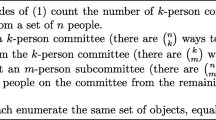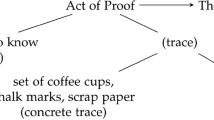Abstract
This chapter provides an overview of data analyzed by authors focusing on the constructs of argumentation, justification, and proof. Data comes from a US-based second-grade (ages 7–8) lesson focusing on the concept of equivalence. Evidence from whole class discussions, as well as written work and use of classroom tools incorporated are described in context.
Access provided by Autonomous University of Puebla. Download chapter PDF
Similar content being viewed by others
Keywords
This section focuses on exploring the constructs of argumentation, justification, and proof in the context of one elementary grade’s lesson. These constructs can often be interpreted differently for the elementary grades, as well as within the elementary grades. Specifically, first-grade teachers consider justification and proof differently than third-grade teachers, and both groups may consider these constructs differently for their students than college mathematics instructors (Rogers & Kosko, 2019). For example, generalization may be fundamental for argumentation and proof in the teaching and learning of advanced mathematics, but it is not always observed as part of these processes in certain elementary grades (Krummheuer, 2007). This might signal a call for more argumentation, justification, and proof in elementary grades, but it may also be contingent on a developmental trend for how and when children develop aspects of argumentation, justification, and proof (Kosko & Zimmerman, 2019). Such issues are also related to how one defines and enacts these constructs: the core emphasis of this book. To this end, the following three chapters include analysis of the same transcript and classroom artifacts from Ms. Kirk’s second-grade classroom.
Ms. Kirk’s Lesson
The class includes students from an economically diverse, suburban school district in a Midwestern US state.Footnote 1 Ms. Kirk and her students were participants in a quasi-experimental study comparing students’ understanding of equivalence when students participate in one of three conditions. Over a 20-week period, one teacher was provided weekly tasks related to the concept of equivalence. Additionally, the teacher had their students explain and justify their reasoning in writing with each task. Ms. Kirk was provided the same tasks over the same period of time but was only asked to engage her students in discussions to explain and justify their reasoning. A third teacher was not provided the tasks but was provided with the same manipulatives and tools as the other two classrooms in the study (number balances, Cuisenaire rods, and various number line resources). In addition to classroom observations, each teacher was also interviewed at three points in the 20-week period regarding their mathematics pedagogy in relation to concepts being observed in their classroom.
The data described in this chapter come from a math lesson at the end of the first week following Winter Break. Prior to the break, Ms. Kirk and her students used number balances for 5 weeks to develop understanding that both sides of an equation should be equal. In the weeks leading up to Winter Break, the class was introduced to Cuisenaire rods so that they might begin to examine why both sides of an equation are equal (see Fig. 1). As a measurement model, Cuisenaire rods can be used to represent various mathematical relationships and provide a context for discussion of such relationships. Figure 1 provides an illustrative example used in Ms. Kirk’s lesson in which light green (3 cm) and purple (4 cm) rods are juxtaposed with red (2 cm) and yellow (5 cm) rods to convey equivalent lengths (i.e., 3 + 4 = 2 + 5).
Description of the Lesson
The lesson begins with Ms. Kirk pointing to an equation written on the blackboard: 14 + 3 = 15 + 2. At their tables, students have Cuisenaire rods , centimeter-based number lines, and number balances for reference. Wanting to refresh students’ memories after the long break, she points to the equals sign asking students what it means to them. Landon says “the same as.” Katie says “equal.” Jacob says “combined.” Some students recall manipulatives they used to solve equivalence tasks. Hayley notes Unifix cubes, Madeline points to the Cuisenaire rods at their group tables, and Kaylyn describes the number balance. After several minutes of discussing students’ meanings of the equals sign and how they used different tools to understand it, the teacher returns to the equation on the board and tells the students to work with their peers, using the Cuisenaire rods , to show whether or not the equation is true.
After several minutes of students working together, Ms. Kirk stops the class to discuss one group’s representation of the problem:
Ms. Kirk: So I was talking with Carrie and Amanda, and they represented the problem really well. They showed me the purple, and said it was four. And the green and said it was three. And then they showed me the yellow and said it was five. And the red and said it was two. And I took away from them their number line and I said “just using this…can you prove to me that four plus three is the same as five plus two?”
As Ms. Kirk talks, she notably takes the 4 + 3 from 14 + 3 and 5 + 2 from 15 + 2 that is represented on Carrie and Amanda’s table. Following her question about showing they are equal without the number line, which identifies each individual unit, various students loudly shout yes. Surveying the class, Ms. Kirk calls on Sammy to explain how they are equivalent. Moving to the document camera where Ms. Kirk had placed the purple (4) and light green (3) rods next to the yellow (5) and red (2) rods, Sammy states that “if you go make the four a five and the three a two and that would make the seven and it would be equal.” The teacher asks how she can be sure that the two are equal, to which Sammy replies that “you can tell if you put them together.” Sammy carefully pushes the 4 + 3 length to juxtapose the 5 + 2 length (see Fig. 1 for reference). After confirming that both pairs of rods are the same length, Ms. Kirk and her students move to the next task.
Ms. Kirk passes out a recording sheet with ____ + ____ = ____ + ____ written at the top. “With your partner, I’m asking you to discuss and plan how you can use the Cuisenaire rods to help you design a math equation that is true. Explain how you can prove that it is true.” After a brief discussion clarifying the task at hand, students return to their seats and work for several minutes creating their own equations and using the Cuisenaire rods and number lines to model various equations:
Ms. Kirk: Sammy and her partner [Jacob] also worked on something interesting. They tried to go after a larger number that they could still prove with their Cuisenaire rods. Here, I’ll move this up here and you guys can explain.
Ms. Kirk moves the students’ work and places their number line and rods on the document camera. Jacob begins pointing at the two expressions modeled, 40 + 9 and 27 + 22 (see Fig. 2):Footnote 2
Jacob: So this one is 10, this one is 10, 10 and 10. So this one is nine. So that’s 49. 40 plus nine equals the same as 27 plus 22.
Ms. Kirk: Woah. So it’s a little bit hard to tell that these are the same because they broke their rods in half to fit on their number line.
Katie: Why did they break it in half?
Ms. Kirk: Because they were trying to get it to fit on the number line.
Katie: Oh.
Ms. Kirk: If we just take these, can you guys line those up all in one line for me?
Jacob and Sammy begin to arrange the rods side by side on the floor where the rest of the class can see it from their tables (see Fig. 3). As they are arranging the rods, Ms. Kirk continues the discussion with the rest of the class:
Ms. Kirk: If what they’re saying is true [40+9=27+22], if we lined each side up, what should it look like? Tony.
Tony: A big line that is the same on both sides and is equal.
Ms. Kirk: It’s the same length, right? The lengths are equal. I’m not sure if you can see from your seats, but when we line them up next to each other….
Katie: They are equal.
Ms. Kirk: They are equal.
Katie: Yeah.
At this point in the lesson, the teacher looks at the clock and asks students to place their Cuisenaire rods back in their containers and to leave everything else at their tables. The students then line up to leave the classroom to go to a different classroom.
Conclusion
The authors in this section conducted secondary analysis of the transcribed data, along with samples of children’s written work and images of interactions (student-to-student and students-to-teacher) from the lesson. It represents only a snapshot of classroom practice in Ms. Kirk’s classroom. As such, the authors were limited in certain aspects of their analysis (i.e., sociomathematical norms, typical tasks used in the class). However, a shared analysis of a snapshot can be useful in understanding the contributions of different theoretical perspectives and analytic approaches. Independently, each of the next three chapters offers a useful conceptualization of argumentation, justification, and proof. In the final chapter of this section, Stylianides & Stylianides (this volume) consider both the affordances and consequences for how these constructs are considered in relation to this specific dataset but also more generally.
Notes
- 1.
The school district had adopted Investigations in Mathematics (2nd Edition) as their textbook, provided frequent professional development opportunities for elementary mathematics, and advocated reform-oriented pedagogy in each of their schools.
- 2.
Partners worked with individual Cuisenaire rod sets (72 rods), including only four each of orange rods (10 cm), blue rods (9 cm), and brown rods (8 cm). Smaller rod lengths were included at higher frequencies in each set.
References
Kosko, K. W., & Zimmerman, B. (2019). Emergence of argument in children’s mathematical writing. Journal of Early Childhood Literacy, 19(1), 82–106.
Krummheuer, G. (2007). Argumentation and participation in the primary mathematics classroom: Two episodes and related theoretical abductions. Journal of Mathematical Behavior, 26, 60–82.
Rogers, K. C., & Kosko, K. W. (2019). How elementary and collegiate instructors envision tasks as supportive of mathematical argumentation: A comparison of instructors’ task constructions. Journal of Mathematical Behavior, 53, 228–241.
Author information
Authors and Affiliations
Corresponding author
Editor information
Editors and Affiliations
Rights and permissions
Copyright information
© 2022 The Author(s), under exclusive license to Springer Nature Switzerland AG
About this chapter
Cite this chapter
Kosko, K.W. (2022). Overview of the Elementary Level Data. In: Bieda, K.N., Conner, A., Kosko, K.W., Staples, M. (eds) Conceptions and Consequences of Mathematical Argumentation, Justification, and Proof . Research in Mathematics Education. Springer, Cham. https://doi.org/10.1007/978-3-030-80008-6_2
Download citation
DOI: https://doi.org/10.1007/978-3-030-80008-6_2
Published:
Publisher Name: Springer, Cham
Print ISBN: 978-3-030-80007-9
Online ISBN: 978-3-030-80008-6
eBook Packages: EducationEducation (R0)







